The first five students
The first five students arrived in Hitchin in October 1869. They were (left to right in the photo) Emily Gibson, Sarah Woodhead, Isabella Townshend, Rachel Cook (seated) and Louisa Lumsden (seated). Three would become the first women to pass Tripos examinations, which they sat on exactly the same terms as men: Sarah in Mathematics and Louisa and Rachel in Classics. As they were not allowed to receive the Cambridge BA, Girton awarded them the College Degree Certificate.
Despite disappointment in successive Cambridge campaigns to persuade the University to grant women degrees, the Girton intellectual adventure thrived in subsequent decades. In 1880 Charlotte Angas Scott (1858–1931) achieved the eighth-highest results across the University in the Mathematical Tripos. 1887 saw a further landmark in the history of women’s education when Agnata Ramsay (1867–1931) was placed in the First Class of Part I of the Classical Tripos, above all the men who had sat those examinations. Other Girtonians went on to achieve similar success in different subjects.
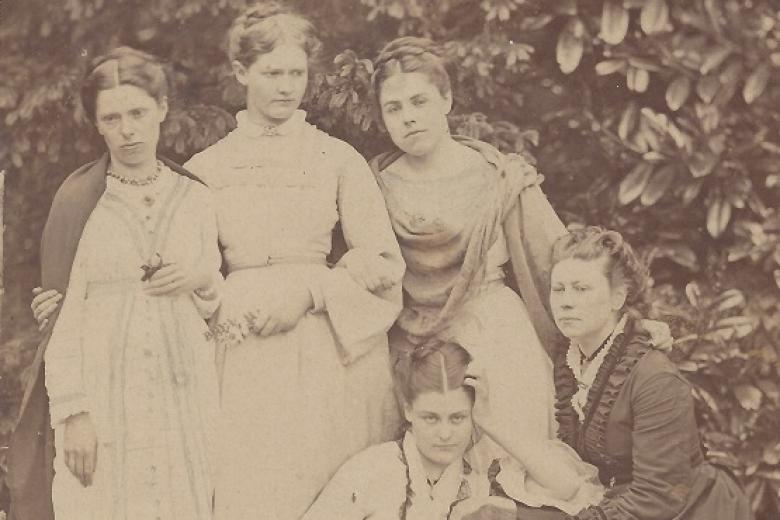 The first five students at Hitchin, Michaelmas 1869 (archive reference: GCPH 7/2/1/1)
The first five students at Hitchin, Michaelmas 1869 (archive reference: GCPH 7/2/1/1)
The Girton fire brigade
The College’s pioneering spirit encouraged Girtonians to turn their hands to many things. In 1879 the Fire Brigade was founded by two students who had witnessed a nearby haystack go up in flames and realized the College would be vulnerable if a fire broke out. Before then, the only fire-precautions at Girton were three small fire engines kept on each corridor which no-one knew how to use. Trained by members of the London Fire Brigade, the Girton Fire Brigade was highly structured: a Head Captain was in overall charge, with a corps for each corridor, led by a Captain and Sub-Captain.
In existence until 1932, the Fire Brigade was only called upon to put out one fire, in Girton village in 1918. However, its existence is testimony to the determination of Girton women to meet any challenges that confronted them.
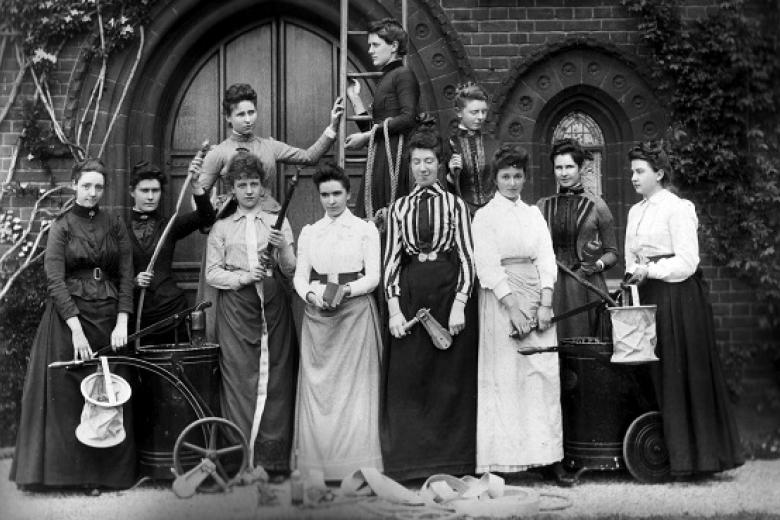 Fire Brigade Officers taken by R H Lord, 1889 (archive reference: GCPH 10/2/3)
Fire Brigade Officers taken by R H Lord, 1889 (archive reference: GCPH 10/2/3)
The early academic staff
The forerunner of the modern Fellowship was the Resident Girton Staff. The first appointee was Louisa Lumsden (1840–1935), Resident Tutor in Classics in 1890.
This photograph shows the Resident staff of 1890. Standing (left to right) are: Marie Anelay (1859–1929), Resident Lecturer in Natural Sciences; Katharine Jex-Blake (1860–1951), Resident Lecturer in Classics and future Mistress; Maud Daniel (1864–1899), Resident Lecturer in Classics; and Margaret Meyer (1862–1924), Resident Lecturer in Mathematics. Seated (left to right) are: Florence Ward (1852–1938), Vice-Mistress and Junior Bursar; Elizabeth Welsh (1843–1921), Mistress and Emily Constance Jones (1848–1922), Resident Lecturer in Moral Sciences and another future Mistress.
Aged between 27 and 46, all had been Girton students. They lived alongside the students, a Housekeeper, a Cook, and 21 female College servants. As well as their lessons with the College staff, students had classes and lectures in Girton given by male Lecturers and Professors who visited the College each day. By special arrangements made by the Mistress, a growing number also attended some lectures in Cambridge.
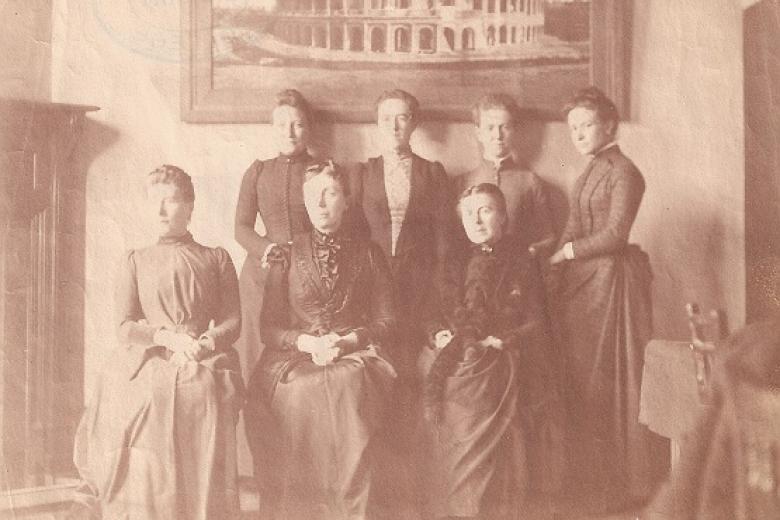 The Resident Staff, circa 1890 (archive reference: GCPH 6/1/1)
The Resident Staff, circa 1890 (archive reference: GCPH 6/1/1)
The first Research Studentship
In June 1897, the College awarded its first official Research Studentship to the astronomer Mrs Annie Maunder (1868–1947). As Annie Russell, she had studied Mathematics at Girton from 1886 to 1889. Chosen from three candidates, Annie was not resident in Girton while holding the Pfeiffer Studentship, but used the £40 award to help complete a ‘systematic, photographic survey of the Milky Way’.
In the late 1890s, former student Florence Durham (1873–1948) led a collection among past students to fund the first resident research studentship.
In 1901 this was awarded to Frances Cave-Browne-Cave (1876–1965) who, from 1903 to 1936, was Girton’s long-serving Resident Lecturer in Mathematics.
From 1904 onwards, the numbers of resident and non-resident research and graduate students would grow to become the talented Girton community of today.
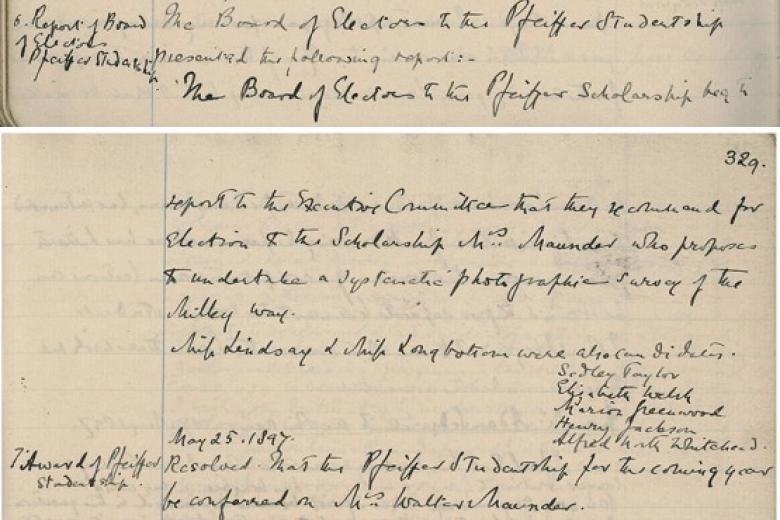 Girton Executive Committee Minute awarding the first Pfeiffer Research Studentship to Mrs Annie Maunder, 14 June 1897 (archive reference: GCGB 2/1/13)
Girton Executive Committee Minute awarding the first Pfeiffer Research Studentship to Mrs Annie Maunder, 14 June 1897 (archive reference: GCGB 2/1/13)
The College Chapel
Girton Chapel was opened and held its first service in 1902, led by Anglican clergymen, including John Llewelyn Davies (1826–1916), brother of Emily Davies (1830–1921).
The decision to build a chapel was controversial. Construction only went ahead after the death of Henrietta, Lady Stanley of Alderley (1807–1895). Religious worship in Girton was not new, however. From its earliest days, although attendance was not compulsory for students or staff, daily prayers were led by the Mistress, and visiting preachers were welcomed for Sunday services.
From the 1870s onwards, a rich tradition of student prayer groups and religious volunteering also developed, gathering significant numbers of students.
Today the Chapel continues the tradition of visiting preachers but is open to those of all faiths and none. Its services are enriched by the voices of Girton’s first-rate choir.
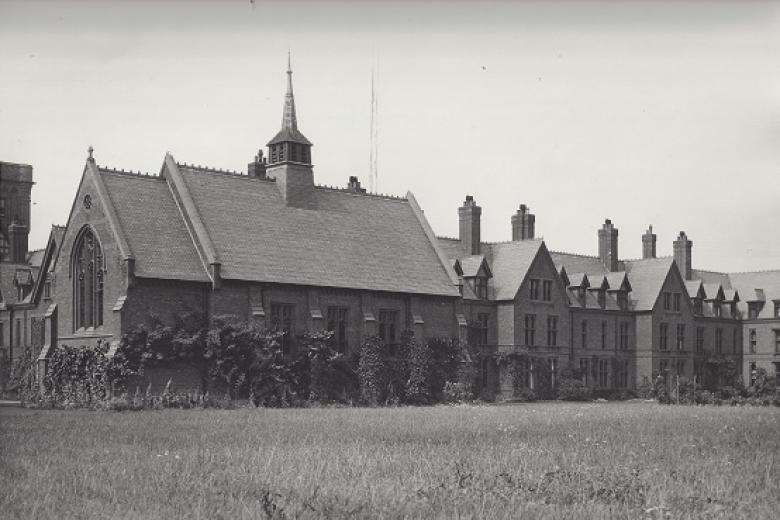 Chapel with Chapel Wing to the right, before the Hyphen and the McMorran Library were built, taken by the Central Press, 1930 (archive reference: GCPH 3/9/3)
Chapel with Chapel Wing to the right, before the Hyphen and the McMorran Library were built, taken by the Central Press, 1930 (archive reference: GCPH 3/9/3)
Hermione
Over the years, Girton has assembled a collection of fascinating historical objects to enrich College life. Some of these are now housed in the Lawrence Room, the College museum. In 1911, Girton welcomed its most extraordinary resident – Hermione, a first-century AD Roman portrait mummy. Bearing the inscription ‘Hermione Grammatike’ (‘Hermione, teacher’ or ‘literary lady’) the mummy was acquired through subscriptions and fundraising among students, staff and College friends.
Now kept in environmentally appropriate conditions, Hermione is one of the few female Egyptian mummies who has a name and the only one with a known profession. She is an important part of the College community, reminding us that for millennia women have played an important role as teachers and helped to create the world we know today.
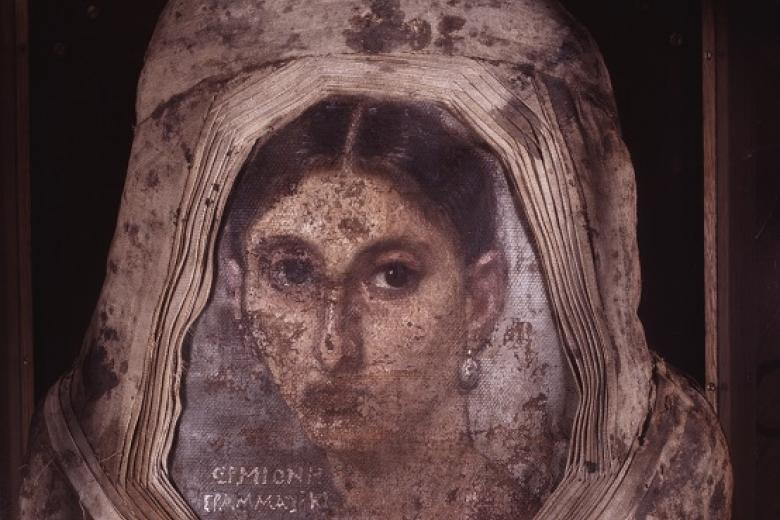 Hermione Grammatike, taken circa 1997 (archive reference: GCPH 11/26/2/6)
Hermione Grammatike, taken circa 1997 (archive reference: GCPH 11/26/2/6)
Sir Alfred Yarrow
The death in 1932 of Sir Alfred Yarrow (1842–1932) closed one of the most critical philanthropic chapters in the history of the College.
In 1914 this wealthy engineer and shipbuilder gave Girton £12,000 which, together with other benefactions, cleared the College’s debts and allowed the creation of the ‘Endowment Fund’ – a further step on the long road to financial sustainability. In recognition of his generosity, Girton created the Yarrow Fellowship.
In 1919, spurred on in part by his experiences in the war, Alfred Yarrow made a further large donation of £10,000 to be used over the coming 20 years to support research in Mathematics and the Physical and Natural Sciences. This generous gift enabled the College to establish the Yarrow Scientific Research Fellowships, held between 1920 and 1940 by 11 talented women.
Amongst these were Frances Hamer (1894–1980), a chemist and pioneer of colour photography, parasitologist Ann Bishop (1899–1990) who was elected a Fellow of the Royal Society in 1959, and Marthe Vogt (1903–1994) pharmacologist and neurochemist who became a Fellow of the Royal Society in 1952.
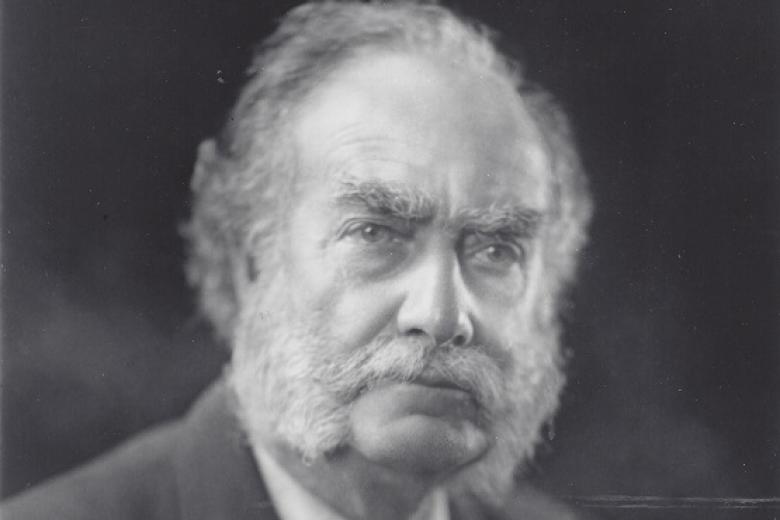 Sir Alfred Yarrow, circa 1915 (archive reference: GCPJ 4/15/1)
Sir Alfred Yarrow, circa 1915 (archive reference: GCPJ 4/15/1)
The first Founders’ Memorial Lecture
At 5pm on Saturday 3 March 1928, Sir J J Thomson (1856–1940), Nobel Prize-winner in Physics, and Master of Trinity College, Cambridge, delivered the first Girton Founders’ Memorial Lecture, ‘Beyond the Electron’, to an audience of 400 in the Dining Hall.
The event was reported in the Telegraph national newspaper. It was the first in what has become Girton’s major and ongoing public lecture series, and was made possible by an endowment gift of £500. Despite the initial wish for anonymity, several Girtonians knew the donor was former student Amy Lawrence (1872-1934). ‘Ever since (I heard) … the thrilling news I have been inwardly purring’, one wrote to Amy: ‘There is nothing, I believe, which could have been better for the College at this juncture, and the gift is simply delightful.’
![Sir Joseph John Thomson, by Bassano Ltd 1936 ©National Portrait Gallery, London [https://www.npg.org.uk/collections/search/portrait/mw69468/Sir-Joseph-John-Thomson?LinkID=mp04489&search=sas&sText=Joseph+John+Thomson&role=sit&rNo=5]. CC BY-NC-ND 3.0 [https](/sites/default/files/styles/780x520_scale_crop/public/timeline-images/Student%20Experience%20Timeline%207.jpg?itok=xF1i2NUk) Sir Joseph John Thomson, by Bassano Ltd 1936 ©National Portrait Gallery, London [https://www.npg.org.uk/collections/search/portrait/mw69468/Sir-Joseph-John-Thomson?LinkID=mp04489&search=sas&sText=Joseph+John+Thomson&role=sit&rNo=5]. CC BY-NC-ND 3.0 [https
Sir Joseph John Thomson, by Bassano Ltd 1936 ©National Portrait Gallery, London [https://www.npg.org.uk/collections/search/portrait/mw69468/Sir-Joseph-John-Thomson?LinkID=mp04489&search=sas&sText=Joseph+John+Thomson&role=sit&rNo=5]. CC BY-NC-ND 3.0 [https
Virginia Woolf visits Girton and Newham
Since its inception Girton has often hosted important women writers and cultural figures. In October 1928, Virginia Woolf (1882–1941) was invited by the students of Newnham and Girton to visit and give talks at each College.
At Girton, accompanied by Vita Sackville-West (1892–1962), she was the guest of a student Society, ODTAA (One Damn Thing After Another) and spoke to a group of its members in the Reception Room.
Some remembered Virginia as goddess-like, others recalled her sensitive hands and untidy grey bob. The redrafted paper she read at the Colleges was subsequently published as A Room of One’s Own, one of the 20th Century’s most influential reflections on gender politics.
![Virginia Woolf, by George Charles Beresford, 1902 ©National Portrait Gallery, London [https://www.npg.org.uk/collections/search/portrait/mw08081/Virginia-Woolf?LinkID=mp04923&search=sas&sText=Virginia+Woolf&OConly=true&wPage=0&role=sit&rNo=1]. CC BY-NC-ND](/sites/default/files/styles/780x520_scale_crop/public/timeline-images/Student%20Experience%20Timeline%208.jpg?itok=6c_jrBCY) Virginia Woolf, by George Charles Beresford, 1902 ©National Portrait Gallery, London [https://www.npg.org.uk/collections/search/portrait/mw08081/Virginia-Woolf?LinkID=mp04923&search=sas&sText=Virginia+Woolf&OConly=true&wPage=0&role=sit&rNo=1]. CC BY-NC-ND
Virginia Woolf, by George Charles Beresford, 1902 ©National Portrait Gallery, London [https://www.npg.org.uk/collections/search/portrait/mw08081/Virginia-Woolf?LinkID=mp04923&search=sas&sText=Virginia+Woolf&OConly=true&wPage=0&role=sit&rNo=1]. CC BY-NC-ND
The Great Depression
During the Great Depression of the 1930s, with its accompanying hardship and unemployment, avid political discussions took place in Girton and across Cambridge.
In College, a student committee chose the newspapers available in the Reading Room. By the end of the decade several new subscriptions appeared, including the Manchester Guardian, the Scotsman, the Daily Telegraph and the Daily Worker, joining traditional subscriptions such as The Times, the Nation and Punch. Political discussion also occurred in the long-standing College Debating Society and in political societies of various hues.
The Girton Socialist Society welcomed regular visiting Lecturers, including an economic advisor to the Russian Co-operative Movement who delivered a lantern-slide talk on Russia, and a representative of the Railway Clerks’ Association who spoke on ‘the Railway Situation’. Helen Cam (1885–1968) talked on ‘Why I am a Socialist’. It was, however, compassion as well as politics that inspired the student members of that society to provide food and drink at Girton Corner for unemployed marchers making their way towards London in 1934.
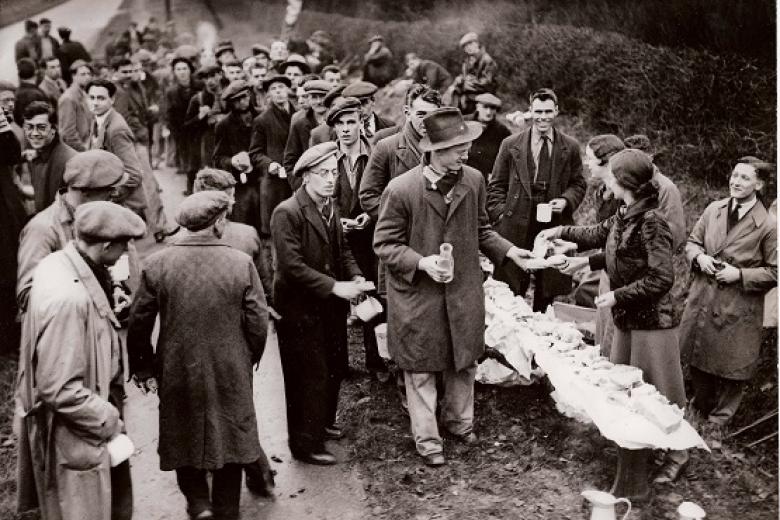 Girton students feeding the hunger marchers at Girton Corner, taken by the Associated Press, 1934 (archive reference: GCPH 7/1/12b)
Girton students feeding the hunger marchers at Girton Corner, taken by the Associated Press, 1934 (archive reference: GCPH 7/1/12b)
Girton: an escape from the blitz
Girton is distinctive for its warm welcome and ingrained ethic of care. In this spirit, during the Second World War, the College welcomed groups of new residents who were either escaping danger or working for the war effort.
In 1939–1940, Girton gave a new home to 56 women students and two staff evacuated from Queen Mary College in London until they found more spacious accommodation in Cambridge. Many Girtonians shared rooms to make space for the visitors and, in 2006, some Queen Mary evacuees came back to Girton for a reunion.
In 1939 the Girton College Refugee Fund was established, which would help three Czech and German student refugees to attend College. It also supported the war-time residence of Dr Elsbeth Jaffé (1889–1971), a scholar from Germany. The Grange, a house in the College grounds, was occupied by the army during some of these years, and from 1943 Girton also provided a home for a small number of women of the Voluntary Aid Detachment [VADs].
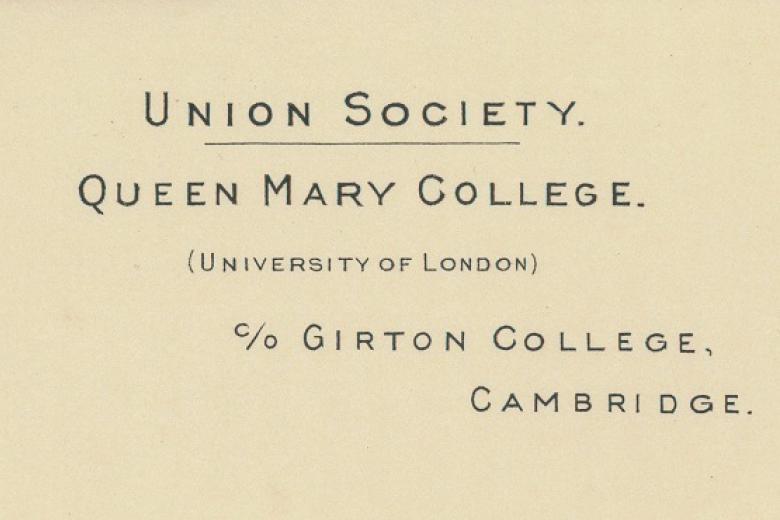 Queen Mary College, Union Society headed note paper, 1939–1940 (archive reference: GCPP Blacklocks 2)
Queen Mary College, Union Society headed note paper, 1939–1940 (archive reference: GCPP Blacklocks 2)
Drama at Girton
Dramatic performances of all kinds, from charades and sketches to plays and ‘musical interludes’, have always been an important part of Girton life.
The 1950s witnessed some innovations within this tradition. The 1953 Staff Party was entertained by the pantomime Dick Whittington, written and produced by members of the College, with its charming heroine, Girtonella. Early English operas, staged under the guidance of Girton’s Director of Studies in Music from 1948 to 1968, Jill Vlasto (1916–1968), delighted audiences. Continuing innovative work begun in the 1940s, there were productions of Monteverdi’s Orfeo (1950) and Landi’s Il Sant’ Alessio (1952).
Another highpoint was the 1953 performance by the College English Club of Mrs Inchbald’s Lover’s Vows, loosely adapted from Jane Austen’s Mansfield Park: ‘The greatest applause of the evening was for Miss Bradbrook’s (1909–1993) entry, as Lady Bertram come to see the play’. Miss Bradbrook had insisted on making her own dress, and the audience wished that ‘more dons would appear on the stage with feathers in their hair’.
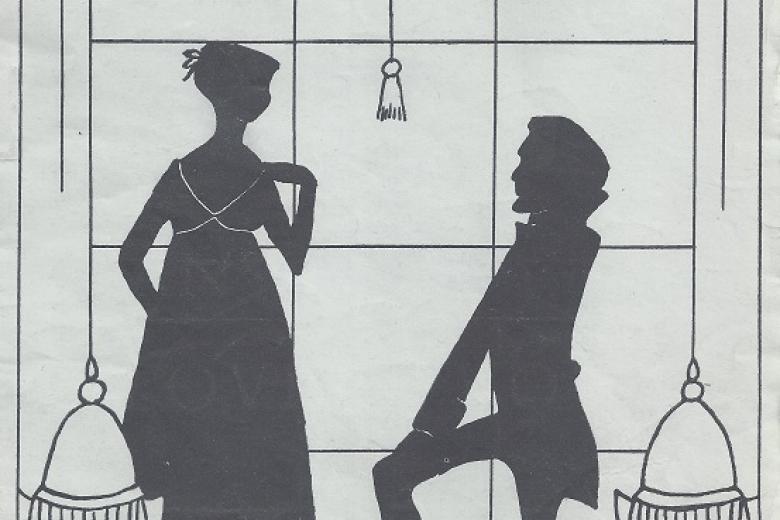 Programme for Mrs Inchbald’s ‘Lovers’ Vows’, 1953 (archive reference: GCPP Duke 4/7)
Programme for Mrs Inchbald’s ‘Lovers’ Vows’, 1953 (archive reference: GCPP Duke 4/7)
Student activism
International activism animated 1960s Cambridge and Girtonians were among those who campaigned and demonstrated on a wide range of issues. Midi Berry (English, 1964), born Hughes-Owen, remembers protests in London and Cambridge and especially events around the Garden House Hotel in late winter 1970:
'After a Test Ban Treaty diluted anti-nuclear campaigning, Vietnam became a demonstration target. Most Cambridge students at a London March, 1968 anti-war rally, side-stepped Grosvenor Square violence, and November saw 800 anti-Enoch Powell demonstrators outside the Cambridge Union protest peacefully. A student-run Shilling Paper fired late-60’s dissent. Its leaders organised an anti-Junta blockade of a Garden House Hotel dinner in the centre of Cambridge held to promote Greek Tourism in February 1970. Property damage, injuries to police and students, and harsh prison sentences shocked the world beyond Cambridge. Disaffected radicals returned to their studies, leaving moderates to address University domestic issues.’
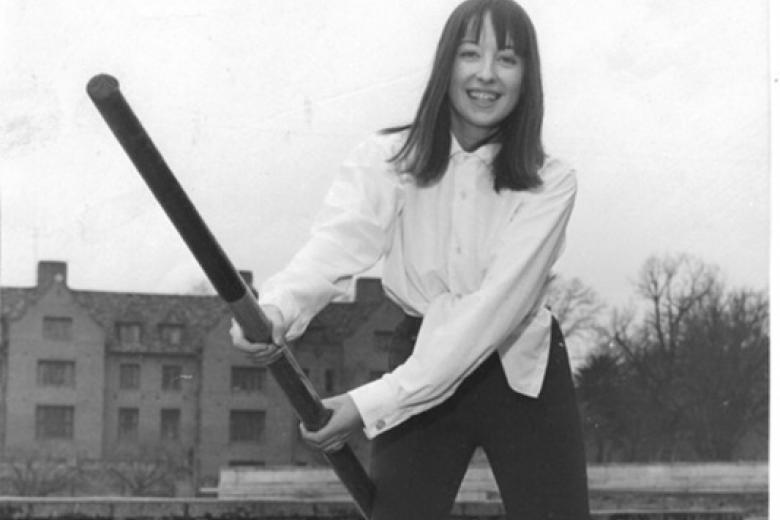 Midi Berry (1964, English) punting in Cambridge c1965
Midi Berry (1964, English) punting in Cambridge c1965
First male undergraduate student
The first male undergraduate intake of 58 students came in 1979. One was Jon Harbor (1979 Geography), now Professor at Purdue University in the US: “It was a place with lots of friends many of whom were like older or younger sisters to me for some years.”
Also, Ian Power (1979 Natural Sciences): “On that first visit, that first drive under the archway (at Girton) there was something special, somewhere that I would dearly love to be. It was only much later I realised the significance of Girton as a place, not just for now and the future, but for its unique past too”.
The first man admitted as a graduate was Canadian, Piers Bursill Hall (1977 PhD HPS).
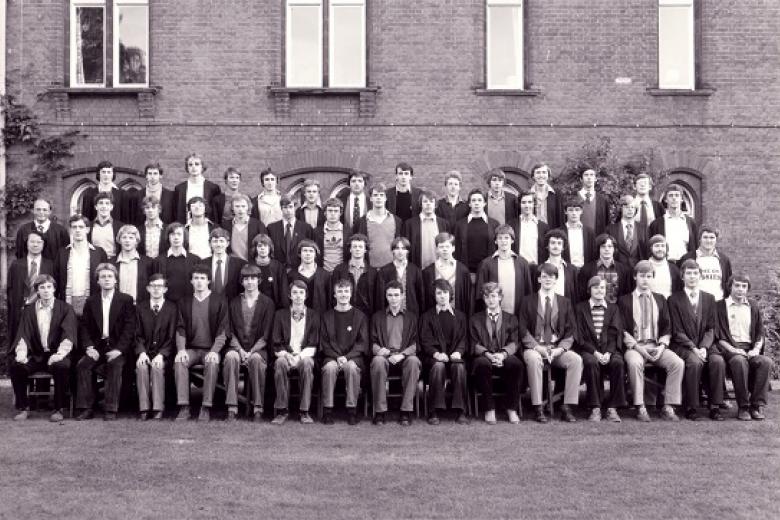 Matriculation photo of male undergraduate students, 1979 (photograph: Lafayette Photography)
Matriculation photo of male undergraduate students, 1979 (photograph: Lafayette Photography)
Sport going mixed
Sport and sporting success has been a feature of Girton since its earliest days. Girton’s grounds boasted excellent on-site sports facilities including a hockey field, tennis courts and a swimming pool. But when Girton went co-residential, sport took on another dimension. Space for rugby and football pitches was needed and a cricket pitch was reintroduced. The first intake of male students threw themselves into forming teams, regardless of prior experience.
“By the end of the first week of the 1979 Michaelmas Term, Girton had a men’s team in rugby, soccer and squash as well as an eight on the river — all taken from some twenty men who understood at least the principles of these sports, if not the finer points.” So wrote John Marks, recalling “an enduring memory is the men’s eight winning blades for the first time and rowing back with flag flying and bagpipes playing in the bow seat”. Girton’s list of Blues rapidly acquired male names: in 1979 an early Blues footballer was graduate student Mike Power.
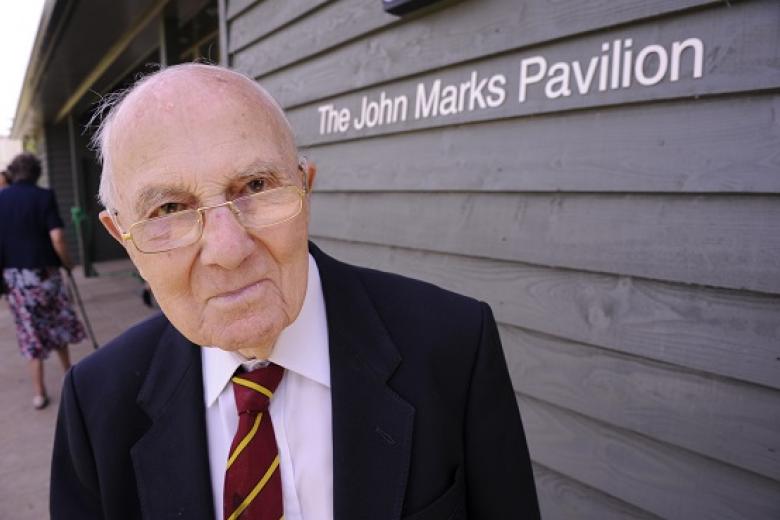 Dr John Marks, at the 2013 Opening of the John Marks Pavillion
Dr John Marks, at the 2013 Opening of the John Marks Pavillion
A dramatic change to student finances
The introduction in the UK of student fees and loans in 1997 for both academic tuition and living costs has meant rising student debt. In 2018 students will be graduating from university with an average debt of £50,000. This debt poses a practical and psychological problem and can deter good students from applying to Girton.
In order to ease this financial burden, the College is committed to offering means-tested undergraduate bursaries of up to £3,500 a year to those most in need of support. Indeed one in four of Girton’s undergraduates in 2018 qualified for this assistance and for many it is the deciding factor that makes a university education accessible.
In addition many more students, both undergraduates and graduates, receive hardship funds for unexpected emergencies, easing their financial situation and allowing recipients to refocus on their studies and successfully complete their course.
 Ruairi Mackenzie (2016, Medical Sciences), 2017 telethon caller raising funds to endow undergraduate bursaries
Ruairi Mackenzie (2016, Medical Sciences), 2017 telethon caller raising funds to endow undergraduate bursaries
Art matters
There are now over 600 pieces in Girton’s vibrant and diverse art and sculpture collections (excluding the museum collection of artefacts) by more than 400 artists. The range is broad and features works created between the fourteenth and twenty-first centuries. These include, for example, pieces by Francesco di Vannuccio, Barbara Leigh Smith Bodichon, Alexander Munro, Stanley Spencer, Winifred Nicholson and David Jones.
Girton is also home to a unique collection of People’s Portraits – paintings of ordinary people from all walks of life. All the portraits – which now number over 50 – have been painted by members of the Royal Society of Portrait Painters. This collection will celebrate its 20th anniversary in 2020.
Since 2013, our biennial Artist-in-Residence scheme has enabled a contemporary artist working across different media to be resident in College for up to a year. Their innovative art now also adorns College corridors.
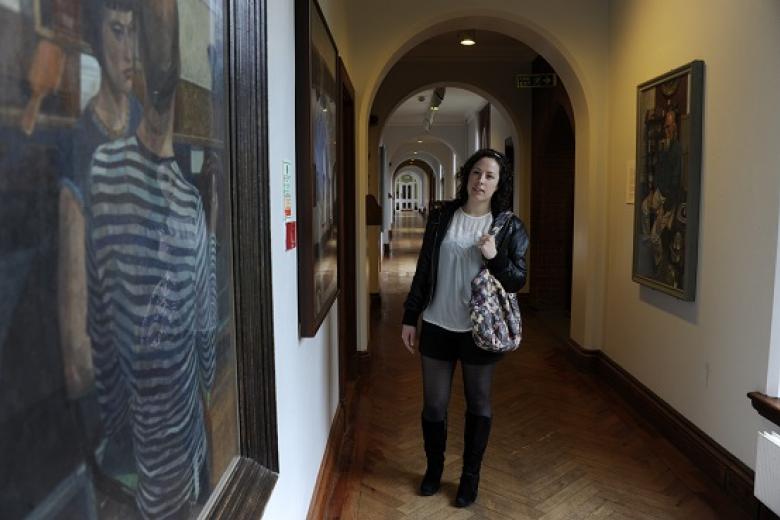 Visitor viewing the People’s Portraits collection at Girton College, 2015
Visitor viewing the People’s Portraits collection at Girton College, 2015
Student representation on College Council
Girton is distinctive in involving students so significantly in College decision-making as their senior officers elected by the Junior Combination Room (JCR) and Middle Combination Room (MCR) sit on Council. Students on the Student Representative Committee, which became the JCR in 1948, first attended Council at its meeting of 18 April 1975.
Previously an exempt charity under UK Charity Law, Girton was required to register with the Charity Commission in August 2010, and all members of Council, including the student representatives, became trustees of the registered charity, Girton College (number: 1137541).
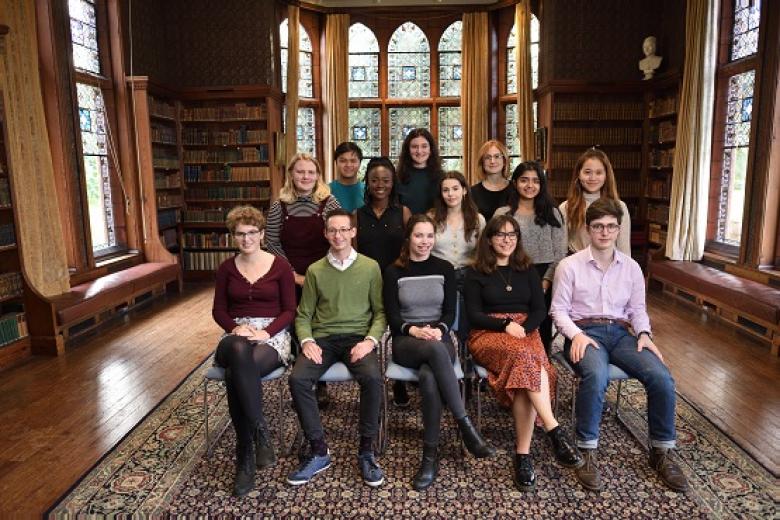 JCR Committee 2018-19
JCR Committee 2018-19
Girton expands into Eddington, NW Cambridge
Girton has extended its operation to embrace Swirles Court, a purpose-built, 325 room student complex in Eddington, the University’s visionary £350 million urban-academic community which is a short walk from College. Swirles Court, named after the Girton mathematician Bertha Jeffreys (née Swirles), was officially opened in October 2017 by the new Vice-Chancellor of the University of Cambridge, Professor Stephen J. Toope. Bertha Jeffrey’s (1921 Mathematics) research focus was on quantum theory in Physics, and she was actively involved with Girton, as student and Fellow, for over 70 years.
However, Girton’s impact on Eddington is even wider. A further eight Girtonians have been selected by the local community to be inscribed in the landscape, giving their names to streets, neighbourhoods, and buildings on the Eddington site: Hertha Ayrton, Muriel Bradbrook, Mary Cartwright, Emily Davies, Dorothy Hodgkin, Joan Robinson, Charlotte Angas Scott and Lucy Slater.
Acquiring Swirles Court and our impact on the landscape is raising our profile and helping to establish Girton as the College of North West Cambridge.
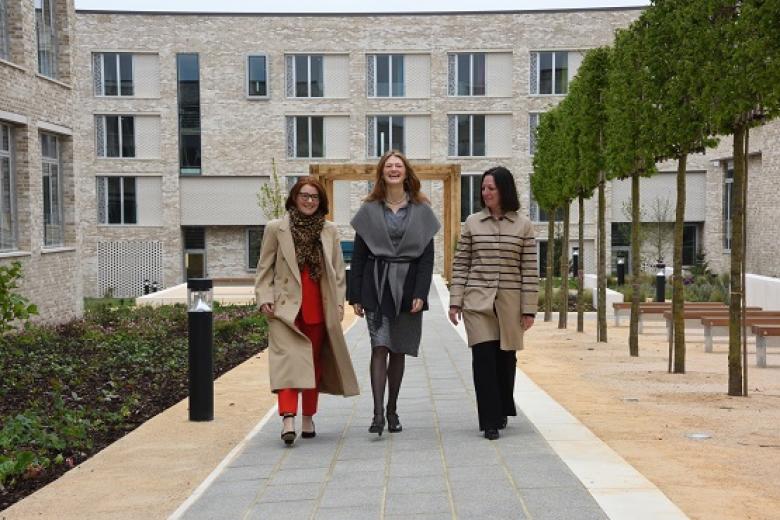 The Mistress and Bursar Visit Swirles Court
The Mistress and Bursar Visit Swirles Court
Growing the Postgraduate community
Collegiate Cambridge is rated as one of the top five universities in the world by most higher education league tables. This international recognition has resulted in a postgraduate community in Girton where more than 40% of those students are from over 40 countries world-wide. Eighteen percent of undergraduates are non-UK, non-EU students. Girton is looking to expand its postgraduate community as well as the number of its international undergraduates.
Today, Girton has 250 postgraduates at any one time, and expects to see this community grow by up to 13% over the next five years, in line with the decision of Cambridge University to increase postgraduate numbers by that amount. By producing more qualified and highly skilled postgraduates, Girton can play a crucial part in boosting a global economy in urgent need of diverse high-level skills and analytical abilities.
Girton is also aiming to increase numbers of international undergraduates, although the overall undergraduate population is not planned to grow. Girton can only benefit from increased diversity across cultures, language, religion, all of which will help enrich our students’ experience, understanding and academic excellence.
 Postgraduate students in Swirles Court check their mail.
Postgraduate students in Swirles Court check their mail.
Centenary for Geography
As Cambridge University celebrates the centenary of the Geography Tripos, it seems fitting that Girton has a geographer as Head of House. Geography is part of a long tradition at College.
The first entrance exam for ‘The College for Women’ included a paper on Physical and Political Geography, for example. As a Tripos subject, Geography flourished almost from the start, thanks to a great degree to the efforts of Margaret Willis Anderson, (1902–1952) the first Girtonian to pass both Parts of the Tripos in 1924 and 1925, and first resident Lecturer in Geography from 1928. She was succeeded in 1953 by Jean Clark Grove (1927–2001) (1953, Plant Sciences), still our longest serving Director of Studies, who revolutionised the way physical scientists understand climate change.
One of Girton’s earliest male Fellows, Roland Randall was, and still is, a geographer who pioneered the study of British and Mediterranean coastal ecosystems.
Today, as in the mid-1920s, there is a large cohort of Geography students, with an all-women research-active teaching team anchored by Harriet Allen (a biogeographer) together with Mia Gray (who, like the Mistress, work on austerity) and Amy Donovan (a volcanologist).
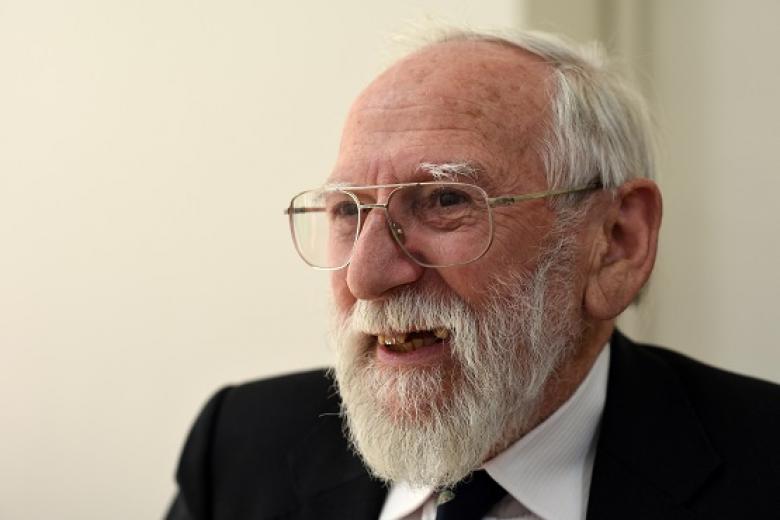 Dr Roland Randall, Life Fellow (2019)
Dr Roland Randall, Life Fellow (2019)
